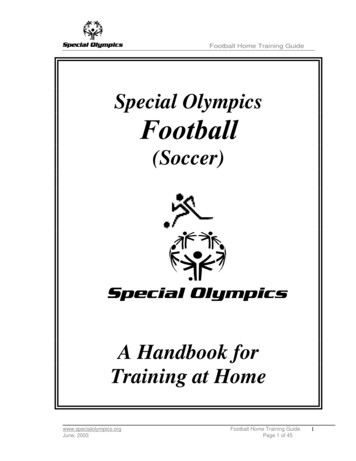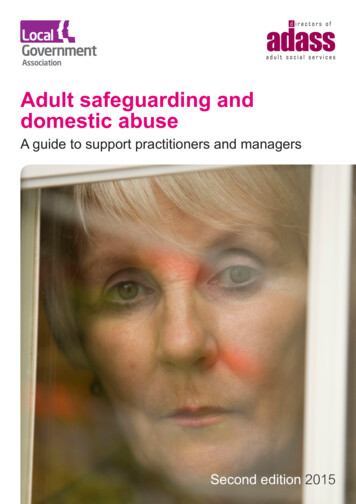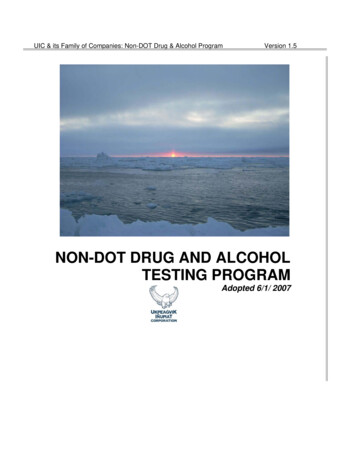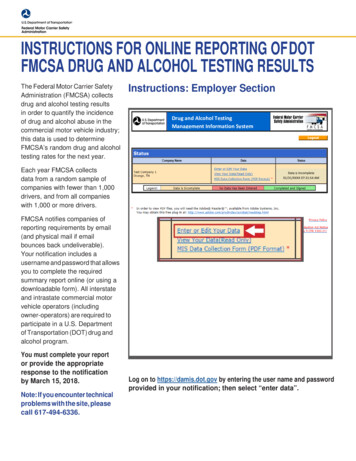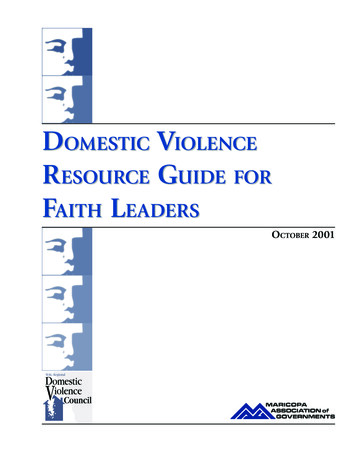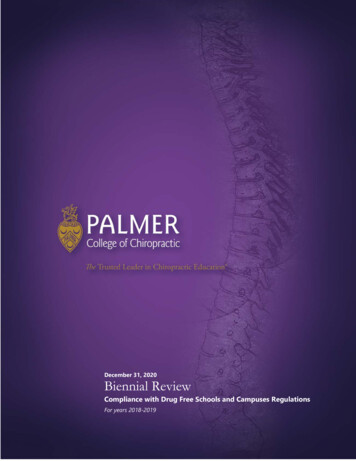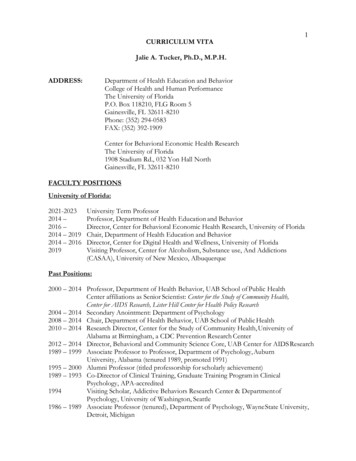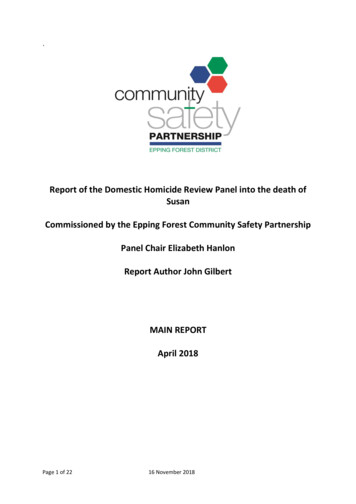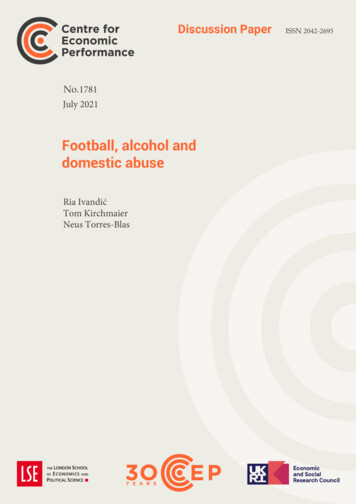
Transcription
Discussion PaperNo.1781July 2021Football, alcohol anddomestic abuseRia IvandićTom KirchmaierNeus Torres-BlasISSN 2042-2695
AbstractWe study the role of alcohol and emotions in explaining the dynamics in domestic abuse following majorfootball games. We match confidential and uniquely detailed individual call data from Greater Manchesterwith the timing of football matches over a period of eight years to estimate the effect on domestic abuse. Wefirst observe a 5% decrease in incidents during the 2-hour duration of the game suggesting a substitutioneffect of football and domestic abuse. However, following the initial decrease, after the game, domesticabuse starts increasing and peaks about ten hours after the game, leading to a positive cumulative effect. Wefind that all increases are driven by perpetrators that had consumed alcohol, and when games were playedbefore 7pm. Unexpected game results are not found to have a significant effect.Key words: domestic abuse, crime, football, alcoholJEL codes: J12; I12; K36This paper was produced as part of the Centre’s Community Wellbeing Programme. The Centre forEconomic Performance is financed by the Economic and Social Research Council.We thank Juan Llavador Peralt for excellent research assistance. We thank Anna Bindler, André Diegmann,Nadine Ketel, Olivier Marie and other seminar participants for their helpful comments. Special thanks alsoto Ian Hopkins QPM, Rob Potts, Chris Sykes, as well as Gwyn Dodd, Emily Higham, Peter LangmeadJones, Duncan Stokes, and many others at Greater Manchester Police for helping to make this projectpossible. All findings, interpretations, and conclusions are the views of the authors and not those of the GMP.No financial support was received for this project. All remaining errors are our own.Ria Ivandić, Centre for Economic Performance, London School of Economics. Tom Kirchmaier,Copenhagen Business School, London School of Economics and Centre for Economic Performance, LSE.Neus Torres-Blas, London School of Economics and Centre for Economic Performance, LSE.Published byCentre for Economic PerformanceLondon School of Economics and Political ScienceHoughton StreetLondon WC2A 2AEAll rights reserved. No part of this publication may be reproduced, stored in a retrieval system or transmittedin any form or by any means without the prior permission in writing of the publisher nor be issued to thepublic or circulated in any form other than that in which it is published.Requests for permission to reproduce any article or part of the Working Paper should be sent to the editor atthe above address. R. Ivandić, T. Kirchmaier and N. Torres-Blas, submitted 2021.
1Introduction"I used to dread the World Cup ‘cos he wasn’t a drinker my husband but could guaranteecome the World Cup he’d drink, ‘cos he’d be with all his friends watching it at whoever’shouse, mine, in pub, wherever, and that’s where he drinks and he get even nastier whenhe’s had a drink, not a very nice person." - Ann"(.) also knew that if other guys in the pub, if they lost a match, I knew their wiveswouldn’t be out at the weekend, because they’d have a black eye.or busted ribs or somethinglike that, I just knew." - Deb1Reported domestic abuse victimization constitutes a sharp escalation point ina person’s life, putting the individual on a different life trajectory. This leads tosignificant and sizeable economic loss. Bindler and Ketel (2019) find that being avictim of domestic abuse leads to an 18% decrease in earnings and increases the timereceiving welfare benefits by 42%. First time victimisation also sets the trajectory tomore victimization and criminal involvement (Grogger et al. (2020), Bland and Ariel(2015)). Spillovers of domestic violence are shown to affect the incidence of adversebirth outcomes exacerbating inter-generational inequality (Currie, Mueller-Smithand Rossin-Slater (2018)) and decrease educational outcomes for both the affectedchildren and their school peers (Carrell and Hoekstra (2010)).Equally pertinent to understanding domestic abuse victimization is how widespreadit is. One out of three women in the United Kingdom, and worldwide, report havingexperienced domestic abuse at one point in their lives (Office for National Statistics(ONS) (2019), Hirschel, McCormack and Buzawa (2017)). Although this life eventleads to irreversible economic losses both for the individual and society as a whole,there is limited evidence about what triggers domestic violence. Factors that havebeen identified in the literature include wage inequality within the household (Aizer1Victim testimonies from Swallow (2017).2
(2010); Anderberg and Rainer (2013); Anderberg et al. (2015)) and backlash afterthe desire to divorce or to leave the relationship (Ellis, Stuckless and Smith (2015),Ellis (2016)).While the majority of the identified causes of domestic abuse result from drasticchanges in life circumstances, there is also considerable anecdotal evidence (Swallow(2017)) how exogenous events lead to spikes in domestic abuse, one of them beingsporting events. Police forces around the world have identified surges in domesticabuse reports following big sport events in national and international competitionslike the football World Cup2 . In spite of the anecdotal evidence given by policeforces and organizations like victim shelters, the existence of a causal link betweenfootball and domestic abuse, and the mechanism through which it runs, has not beencomprehensively studied (Card and Dahl (2011)). In this paper, we use uniquelydetailed data to estimate the hourly dynamics of intimate partner domestic abuseduring and after a football game. Moreover, we investigate the channels throughwhich sport is related to domestic abuse, whether through heightened emotionalstates or increased alcohol consumption. To conclude, we discuss what policy changesaround the organisation of games would help reduce domestic abuse incidence.This paper uses uniquely detailed and confidential high-frequency administrativedata from a major police force in the United Kingdom, the Greater ManchesterPolice, that combines five datasets on the population of calls and crimes overan eight year period. The novelty of this dataset(s) allows us to investigate thechannels through which football affects domestic abuse with great precision. Theserecords contain detailed information on the timing, location, description, type ofrelationship, information on the victim and information on the perpetrator, amongother. We complement this with data on all football matches of Manchester United2Dearden, Lizzie. 2015. "Domestic abuse reports soared during the World Cup, police figures show",The Independent, 08 September 2018.3
and Manchester City in different tournaments held between April 2012 and June 2019- amounting to almost 800 games - with detailed data on the timing, location, result,and ex-ante winning probabilities of the game. We construct 2-hourly time seriesdata on the incidence of different types of abuse and run event study specificationswith controls to account for the time dynamics of domestic abuse by season, day ofweek, and time of day.We study the dynamic treatment effects using four leads before the event andeight lags after. The cumulative effect of a football game is therefore captured byeight lags spanning the 16 hours following the start of the game. We examine theeffect on other types of domestic abuse such as ex-partner abuse to show that theeffect is truly driven by the presence of a partner during and in the aftermath ofa football game. Using individual descriptions of the call to the police, we alsodetermine whether the perpetrator was under the influence of alcohol. In addition,we use the difference between the ex-ante probability of winning and the ex-postresult of a match to disentangle if the effect is driven by emotional reactions tounexpected results or increased consumption of alcohol.We establish that a football game changes the dynamics of domestic abuse (DA).First, we observe a 5% decrease in DA incidents during the 2-hour duration of thegame suggesting a substitution effect of football and domestic abuse. However,following the initial decrease, and after the game current partner domestic abusestarts increasing and peaks about 10-12 hours later. In aggregate, the short and longterm increase offsets the initial substitution effect leading to a positive cumulativeeffect. This amounts to an average hourly increase of 2.8% for each hour of a gameday.Once we disaggregate the data by gender of perpetrator, we find that the effectis entirely driven by male-on-female abuse while female-on-male abuse remains4
unchanged. Similarly, we find that the dynamics of DA between ex-partners remainunaffected by football games demonstrating that even though the timing of thegames is not necessarily exogenous, it doesn’t correlate to the times that domesticabuse generally occurs.Our second finding speaks to the mechanism that explains why football canlead to higher incidence of domestic abuse. We argue that the increase in domesticabuse is a result of increased alcohol consumption, but not the effect of heightenedemotions. We establish the latter by testing whether the outcome of the game(win or loss), or any surprise element associated with it, affects the probabilityof abuse and find no evidence for this. Therefore, we show that the increases indomestic abuse are exclusively driven by the increase in alcohol related domesticabuse incidents following a game, while DA caused by a non-alcoholized perpetratorsremains stable.Finally, we find that the largest increases in domestic abuse occur when footballgames are scheduled early in the day. We hypothesise that this leads perpetratorsto start drinking alcohol earlier and continuing to do so through the afternoonand evening. On such days, we estimate strong increases in domestic abuse drivensolely by alcoholized perpetrators. For games later in the day, we do not observeany increase in alcoholized or non-alcoholized domestic abuse. To the best of ourknowledge, this is also the first causal evidence of the role of day drinking on domesticabuse.Our research contributes to the role of sports as initiators of domestic abuse(Montolio and Planells-Struse (2016), Rees and Schnepel (2009)). Specifically, weare able to add very precise domestic abuse time dynamics that follow a footballgame. Our main contribution is understanding the mechanism behind these effects.Using comprehensive data on all games in close to a decade, we are able to rule out5
that any role of heightened emotional responses triggered by the games themselves(Card and Dahl (2011)).Our results point to the main role of alcohol and direct exposure of the victimto the perpetrator, as determinants of domestic abuse in the aftermath of the game.Watching football games coincides with much higher levels of alcohol consumptionwhich in turn, when mixed with presence of one’s partner (Bindler, Ketel andHjalmarsson (2020)) in an alcoholized state, incites intimate partner abuse. Ourinsights have important policy implications when thinking about mitigating therelationship between sports and abuse. Scheduling games later in the evening andimplementing policies that reduce drinking can prevent a majority of the footballrelated abuse from occurring.The paper is organized as follows. Section II provides a literature review ofthe existing evidence of the effect of football on domestic abuse. The subsequentsections describe the institutional background, data and event study methodology.Section IV depicts the results and Section V concludes with brief discussion of ourcontribution and its implications.2Causes of domestic abuse victimization: alcoholand footballRisk factors identified in the economics and criminology literature that increasethe likelihood of domestic abuse victimization can be grouped into socio-demographicfactors, risky behaviours and environmental factors (Bindler, Ketel and Hjalmarsson(2020)). Within explanations around how one’s environment can increase the chanceof their victimization, the role of sports has been discussed. White, Katz andScarborough (1992) document a statistically significant increase in female hospital6
admissions following a win of the local baseball team, while Boutilier et al. (2017)establish a rise in domestic violence calls to the police following important footballmatches. During the 2010 FIFA World Cup, Brimicombe and Cafe (2012) documenta 27.7% increase in domestic violence cases in Greater London on days whenEngland won a match, and a 33.9% increase when they lost, while Kirby, Francis andO’Flaherty (2013) report a comparable impact in Lancashire. Similarly, Williamset al. (2013) show increases after local derbies in Glasgow. In sum, across a widevariety of sports and contexts, domestic abuse is shown to increase following agame. However, these studies share the disadvantage of examining generally a verylow number of salient games and lack high-quality micro-level victimisation data.Therefore they are unable to differentiate whether the effects are due to generallyhigher likelihood of abuse occurring at times when games are scheduled (e.g. theweekend) or whether these effects are present exclusively for the very salient andcompetitive games. These limitations are overcome in Card and Dahl (2011) thatuse the difference in pre-game expectations and the result of the game as exogenousvariation in the triggered emotional response and find increases in domestic abuseprimarily driven by an upset loss. However, while their estimates capture an averageeffect of an unexpected emotional shock, they do not estimate the average effect of afootball game. We overcome the data limitations previously met in the literature byexploiting unique administrative data on all calls to the police over a period of eightyears matched to all football games played during that time. The wealth of thedata allows us to test the plausibility of the exogeneity of the timing of the game toDA and to differentiate between short- and long-term effects of a game by hour ondomestic abuse.Understanding why football games lead to domestic abuse can have importantimplications for public policy, including how games are organised or how information7
campaigns are designed. Two main explanations have been put forward in theliterature: strong emotional reactions caused by the game and increased alcoholconsumption.The first argues that the increase in domestic abuse is caused by strong emotionalreactions of football fans to the game, that are stronger after unexpected resultsdue to the effect of reference dependence (Wann (1993)). As discussed, Card andDahl (2011) use betting odds to control for pre-game expectations and find a 10%increase in male on female domestic abuse immediately after an upset loss comparedto after tied matches. Similar emotional reactions are shown after upset losses acrossother types of violent behaviour (Rees and Schnepel (2009), Kirby, Francis andO’Flaherty (2013) and Munyo and Rossi (2013)). The strength of the emotionalreaction will also depend on the importance of the game: Dickson, Jennings andKoop (2015) only find evidence of loss aversion as a trigger of domestic abuse aftermatches with high stakes in the tournament, and several studies report statisticallysignificant effects after more salient matches: derbies, traditional rivalries or populartournaments (Sachs and Chu (2000), Williams et al. (2013)). However in majorityof these studies as Bindler, Ketel and Hjalmarsson (2020) discuss, "one cannotdisentangle whether these larger emotional shocks trigger more aggression directly,or whether it is indirect via an increase in alcohol consumption". Our contributionto this literature is to use the precise time stamp of calls to disentangle short termeffects, during and immediately after the game when emotions would be highestand the effect would be direct. We also then estimate the medium term effects laterin the day when the role of emotions would be muted. Moreover, using alcoholand drug abuse flags of the perpetrator and victim involved we can explicitly testwhether unexpected results lead to more DA under the influence of alcohol.Literature has emphasised the role of increased alcohol consumption as a trigger8
for criminal behaviour. Francesconi and James (2015) find a 45% increase on arrestsfor alcohol-related incidents due to binge drinking in the UK and Grönqvist andNiknami (2014) use alcohol sale restrictions in Sweden to estimate the effect on crime.Correlational analyses in Leonard (2005) also links higher alcohol consumption tohigher rates of domestic violence, both in frequency and severity of the assaults,after controlling for mediator factors like marital conflicts, anti-social tendencies andaggressive tendencies of the perpetrator. Besides triggering criminality, alcohol alsoincreases the risk of victimization: Chalfin, Hansen and Ryley (2019) use an increasein the probability of alcohol consumption at the legal age cutoff to estimate an effectof 7% higher violent crime victimization for men and 25% increased risk of sexualassault for women. Furthermore, in a study of college football games and crimein the US, Rees and Schnepel (2009) find sharp increases in assaults, vandalism,arrests for disorderly conduct, and arrests for alcohol-related offenses on game days.Lindo, Siminski and Swensen (2018) show a positive correlation between collegefootball games and rape on campus, which they argue is due to the intense partyingand alcohol consumption around the game. Montolio and Planells-Struse (2016)find a rise in a number crime types including domestic violence around football andattributes the effect to alcohol consumption during these periods. Yet, as sportsoften go hand-in-hand with increased alcohol abuse, it is even more difficult todisentangle how much of the increase in abuse can be causally interpreted as aconsequence of alcohol. Our contribution overcomes the data limitations previouslymet in the literature by exploiting the very precise timing of the game and thereported domestic abuse with detailed flags on the alcohol abuse of the perpetrator.We further exploit the different kick-off times within a tournament to estimate thedifferential effect of an early versus a late game, as the former allows longer alcoholconsumption.9
3Data3.1Data on domestic abuseOur data on domestic abuse3 includes the population of all calls to the policein the Greater Manchester metropolitan area (UK) from April 2012 to June 2019.This confidential data, that requires police vetting to access, is provided by theGreater Manchester Police (GMP), the local police force, and is drawn from fivedifferent datasets: the calls for service from the command and control central, thecrime register, a victim dataset, an alleged perpetrator dataset and a dataset withinformation on the relationship between victim and perpetrator.The GMP command and control centre deals with all calls for service either froman emergency number (911), a non-emergency number (101) or the police themselves.Every call to the police is answered by a call handler and given a unique identifiernumber. The handler assigns the urgency of the response to the incident, and one ormore opening codes that give information about the type of incident, which are latercomplemented by closing codes once the incident has been resolved. Together withinformation on the nature of the call, the command and control dataset also containsinformation on the caller, whether they are a victim, a witness or a third person, howthe incident was reported (phone, radio, emergency services), the incident locationand premises, the intervention of the police, the incident outcome (a penalty orcaution, if charges were pressed or not) and finally a crime reference number if thecall resulted in a crime report. Every incident also has a recorded date and timeand a set of coordinates.3The UK defines domestic abuse as "any incident of controlling, threatening behaviour, violence orabuse (physical, emotional, psychological, sexual or financial) between those aged 16 or over who areor have been intimate partners or family members regardless of gender or sexuality." This can includeincidents between siblings, incidents between adult children and parents or intimate-partner incidentsinvolving current or past spouses or romantic partners; it also encompasses a wide range of behavioursthat can be offences of assault, harassment, etc. (Home Office (2012)).10
We restrict our analysis to domestic abuse incidents for the period April 2012to June 2019, a period for which we have complete information on the relationshipbetween victim and perpetrator.4 During this period, 523,546 DA incidents wererecorded; which is 7.23% of the population of 7,239,053 recorded incidents. Of those,90.9% hold data on either the victim and perpetrator, or both, and can be linkedto the respective victim and alleged perpetrator datasets. The dataset containsvariables like ethnicity, gender and age of the victim and perpetrator. It also containsinformation related to the incident such as its risk level, whether any injury wassuffered, if the perpetrator was under the influence of alcohol or drugs when theofficer attended the scene, and if they were arrested for domestic abuse or otherreason. Using the unique identifiers we link both the command and control dataand domestic abuse dataset that records the relationship between perpetrators andprimary victims.5 Finally, we merge incident data with the GMP’s crime registerthrough the crime reference number to get further information on the nature of thecrime, as well as on the victims and perpetrators. 36% of the domestic incidentsconstituted a crime.We study domestic abuse between intimate partners (including both currentand ex-partners, hetero and homosexual) which represents about 2/3rd of totaldomestic abuse. After keeping observations with both victim and perpetrator data,a final sample of 429,491 DA calls from April 2012 to June 2019 is formed which iscollapsed in a two-hourly time series dataset. Table 1 depicts the summary statisticsfor this dataset. On average, there were about 9 recorded cases of domestic abuseacross Greater Manchester every 2 hours. Most of these incidents were acts of maleon female partner violence (77% of all partner incidents, or 83% of heterosexual4In order to do that we filter out those observations that have a closing code of "domestic" assignedby GMP.5This also allows us to identify those incidents of domestic abuse that were committed betweenintimate partners.11
couples) and mainly occurred at home (89%). There were almost as many incidentsbetween current partners as between ex-partners, albeit alcohol was also twice aslikely to feature in DA between current partners. Overall, perpetrators were underthe influence of alcohol in a third of all cases reported to the police.The temporal distribution of calls to the police is such that domestic incidentsare spread equally over the week, with higher incidence on Friday, Saturday andSunday– calls on the weekend amount to 40% of the sample6 . Most domestic abusecalls were made in the early afternoon(32%) or evening(29%). Calls late at night orin early morning constitute 18% of the sample.3.2Football matchesIn order to study the effect of football on domestic abuse we focus on the twomain football clubs in the city: Manchester United and Manchester City. For this wecollected data on all their matches over the observation period. In total, both teamsplayed a combined 780 games, split equally between the two (see 3). They played 38games in each Premier League season as well as other knockout competitions bothat the national level (EFL and FA Cups) and European level (Champions Leagueand Europa League). Additionally, teams might have played in other competitionslike the FA Community Shield or the UEFA Super Cup.Football games are scheduled throughout the week, with evening games likelierduring the week while weekend games have kick-off times through the entire day.Late games (after 7 PM) make up 37% of the sample, while early and mid-afternoonsgames account for 17% and 46% respectively. There is also a higher frequency ofmatches on Friday evenings and the weekend, with 36% of the games occurring then.We record the match result as well as other match characteristics like overtime,6We count days as starting at 6 AM until 6 AM the next day12
penalties or a derby, although the latter only constitutes 6% of the sample. Wecount a "derby" as a match between Manchester City and Manchester United butalso between Manchester United and Liverpool, given their close proximity andlong-standing rivalry. Together with the observed outcome, we also record theexpected results as measured by betting-odds sourced from the two main bettingproviders, Bet365 and William Hill. As there was little discrepancy between thetwo, in our analysis we use only Bet365 odds to capture pre-game expectations.7Given that both Manchester United and Manchester City are among the strongestclubs in the UK, they went on winning most of the games (62%), while losing only20% of the time. The remaining 18% were draws.4Research designWe are interested in estimating the differential time dynamics on a day whenthere is a football game. To do so, our research design estimates an event studyspecification by generalized least squares on a time series of two-hour intervals ofall domestic incidents in Greater Manchester. Since games take place at differenttimes and days of the week, which also vary depending on the week, we exploit thehourly variation in game timings over a 10 year period to identify the causal effectof the sporting event on domestic abuse incidents every two hours. We specify themodel by including eight lags and four leads capturing the full 24 hours aroundthe game, with t indicating the start of it.8 The cumulative effect of a footballgame is therefore captured by eight lags spanning the 16 hours following the start of7We classify a match as expected win if the probability of winning assigned by the betting marketwas equal or higher than 55%; as expected loss if it was smaller than 45%, and as a close match if thewinning probability was between both values. The contrast between the ex ante market prediction andthe result ex post makes it possible to further classify a football match between six exhausting categories:an upset loss, an upset win, a close loss, a close win, a predicted win or a predicted loss.8A typical football game without overtime lasts 90 min, plus a 15 min break in-between, amounts toclose to two hours in total.13
the game. This extended time window is able to capture all the time dynamics ofdomestic abuse on a given game day in the immediate aftermath of the match, laterin the day and in the early hours of the following morning. A shorter time spanwould leave out all incidents resulting from escalating conflicts that may have beentriggered by the match, specially those involving drugs or alcohol, which have beenproven to play a prominent role in domestic violence.In addition, four leads are included to model pre-trends in the 8 hours prior tothe game. For ease of interpretation the two hours immediately before the gamet 1 are used as the reference category, so the coefficients capture the change inthe dependent variable relative to t 1. Given the length of the two-hourly timeseries, all periods outside t 4, 3, ., 7, 8 are binned in a dummy variable Gameτt .Equation 1 depicts the main estimating model:8DAt αt βs Gamet s γ0 Gameτt θt t(1)s 4DAt is the sum of all domestic abuse incidents that were recorded in the two-hourperiod t, Gamet s 9 is a dummy variable equal to 1 if a match started s periods agoand Gameτt is the dummy that bins the rest of periods. Gamet 1 is omitted fromthe regression. θt represents the full set of time fixed effects: year and quarter, dayof the week, hour, interaction effects of day of the week with hour of the day, and aholiday dummy. Finally, t is a random error term. As our outcome variables, DAt ,we use: DA between current partners, current partners with a male perpetrator andfemale victim, current partners with a female perpetrator and male victim, currentpartners with an alcoholized perpetrator, current partners with a non-alcoholizedperpetrator, and ex-partners.9Since we include matches of two football teams, it would be possible to have two games happeningat close times so the sum of all game indicator lags would be bigger than 1, however, this occurs in only3.4% of the observations.14
The leads and time fixed effects control for any linear and non-linear time trendsof unobservables that may affect domestic abuse in a given day. Quarter fixed effectsaccount for seasonal trends as crime surges in summer months, which coincideswith the interruption of the football season,10 while weekday and hour interactionsadditionally capture the changes in daily patterns that happen during the week.Figure 8 shows the descriptive variation of DA incidence across day of week andtime of day. We also control for National holidays to account for a surge in domesticincidents around those days, in particular around the Christmas and New Yearperiod (Card and Dahl (2011)). Our identification assumption for estimating thecausal effect of the games is that, conditional on the time trends, the domestic abuseincidence would have evolved similarly over time in the absence of the game. Henceour control group constitutes days when a football game does not occur, allowing usto compare, for example, the hourly dynamics of domestic abuse on a Saturday inFebruary when a game is played compared to a Saturday in February when a gameis not played. In this sense, the variation of the control group can be thought of as’never-treated’ (De Chaisemarti
to Ian Hopkins QPM, Rob Potts, Chris Sykes, as well as Gwyn Dodd, Emily Higham, Peter Langmead-Jones, Duncan Stokes, and many others at Greater Manchester Police for helping to make this project . London School of Economics. Tom Kirchmaier, Copenhagen Business School, London School of Economics and Centre for Economic Performance, LSE. Neus .
